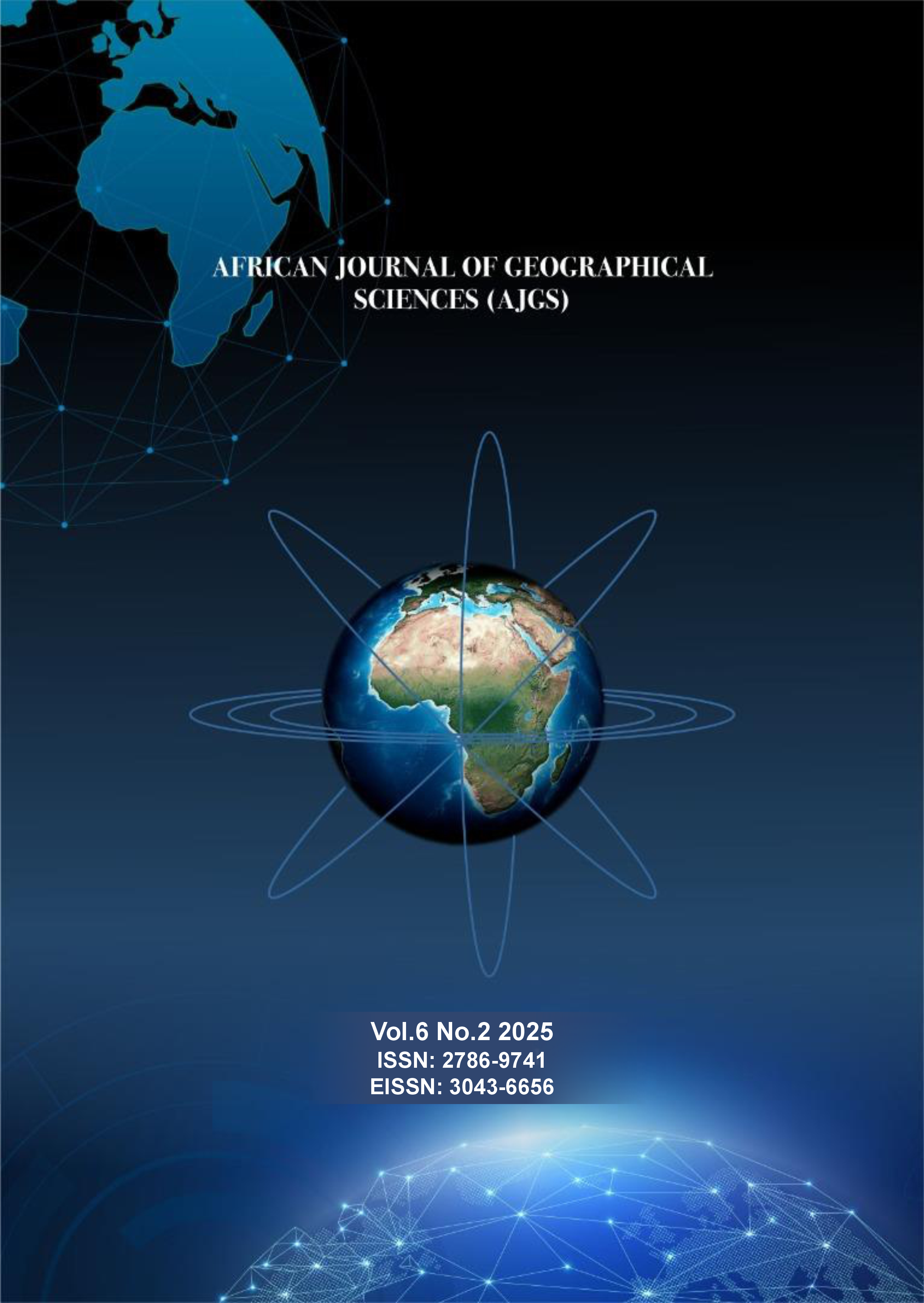ASSESSING HOUSEHOLD AND COMMUNITY LEVEL RISK FACTORS FOR CHOLERA OUTBREAKS IN KATSINA STATE, NIGERIA
Main Article Content
Abstract
This study investigated factors contributing to cholera outbreaks in Katsina State, Nigeria. The study employed a community-based cross-sectional design and surveyed 108 households across five urban and rural communities using a structured questionnaire administered through the Kobocollect digital platform. The data was analyzed descriptively and inferentially (Chi-square tests) in SPSS to examine associations between cholera occurrence and demographic, socioeconomic, water, sanitation, and household characteristics. Key findings showed that children and adolescents (6–17 years) accounted for 54.2% of cholera cases, demonstrating their heightened vulnerability. Larger-sized households (21+ persons) experienced significantly higher cholera incidents (55.6–60%) compared to smaller-sized households (13.2%), revealing the impact of overcrowding. Although households accessed improved water sources, 41.7% of those using pipe-borne water reported cholera cases, indicating contamination risks. However, statistical analysis found no significant association between water source type and cholera incidence (p = 0.255). Spatial analysis identified disparities, with BCG Village recording the highest cholera incidents (50%) and Katoge reporting no cases, emphasizing the role of localized environmental and infrastructural differences. While most households expressed willingness to improve water and sanitation, income level showed only marginal association with willingness (p = 0.053). The study concluded that multiple factors influenced cholera risk, including age, household size, and inconsistent water infrastructure maintenance. Study recommended targeted hygiene education for children and adolescents, household-level interventions to reduce overcrowding, and improved maintenance of water infrastructure.
Article Details
References
Ali, M., Nelson, A. R., Lopez, A. L., & Sack, D. A. (2015). Updated global burden of cholera in endemic countries. PLoS Neglected Tropical Diseases, 9(6), e0003832. https://doi.org/10.1371/journal.pntd.0003832
Azman, A. S., Rudolph, K. E., Cummings, D. A., & Lessler, J. (2012). The incubation period of cholera: A systematic review. Journal of Infection, 66(5), 432–438. https://doi.org/10.1016/j.jinf.2012.11.013
Camacho, A., Bouhenia, M., Alyusfi, R., Alkohlani, A., Naji, M. A. M., de Radiguès, X., ... & Luquero, F. J. (2018). Cholera epidemic in Yemen, 2016–18: An analysis of surveillance data. The Lancet Global Health, 6(6), e680–e690. https://doi.org/10.1016/S2214-109X(18)30230-4
Dardau Hafiz (2021) Social Justice, Distibution and the utilization of Health care services in Katsina State, Nigeria. A PhD thesis submitted to the Department of geography BUK
Debes, A. K., Ateudjieu, J., Guenou, E., Ebile, W., Sonkoua, I. T., Njimbia, A. C., ... & Sack, D. A. (2016). Clinical and environmental surveillance for Vibrio cholerae in resource constrained areas: Application during a cholera outbreak in Cameroon. International Journal of Infectious Diseases, 48, 97–101. https://doi.org/10.1016/j.ijid.2016.05.010
Deen, J., Mengel, M. A., & Clemens, J. D. (2020). Epidemiology of cholera. Vaccine, 38(Suppl 1), A31–A40. https://doi.org/10.1016/j.vaccine.2019.07.078
Ercumen, A., Arnold, B.F., Kumpel, E., Burt, Z., Ray, I., Nelson, K., et al. (2015) Upgrading a Piped Water Supply from Intermittent to Continous Delivery and Association with Waterborne Illness: AMatched Cohort Study in Urban India. PLoS Med 12(10): e1001892. Doi:10.1371/journal.pmed.1001892
Fung, I. C. H., Fitter, D. L., Borse, R. H., Meltzer, M. I., & Tappero, J. W. (2013). Modeling the effect of water, sanitation, and hygiene and oral cholera vaccine implementation in Haiti. American Journal of Tropical Medicine and Hygiene, 89(4), 617–627. https://doi.org/10.4269/ajtmh.13-0201
Gaffga, N. H., Tauxe, R. V., & Mintz, E. D. (2007). Cholera: A new homeland in Africa? The American Journal of Tropical Medicine and Hygiene, 77(4), 705–713. https://doi.org/10.4269/ajtmh.2007.77.705
Ibrahim1 and M. Aliyu (2018), Relief, Drainage and Associated Riverine Landforms in Katsina: A Regional overview Katsina Journal of Natural and Applied Sciences 7(2) September 2018
Katsina State Investment Promotion Agency, (2023) information on infrastructural facilities. Katsina State Government https://katsinastate.gov.ng>upload>2024/01
Lessler, J., Moore, S. M., Luquero, F. J., McKay, H. S., Grais, R., Henkens, M., ... & Azman, A. S. (2018). Mapping the burden of cholera in sub-Saharan Africa and implications for control: An analysis of data across geographical scales. The Lancet, 391(10133), 1908–1915. https://doi.org/10.1016/S0140-6736(17)33050-7
NPC (2006) National Population Commission of Nigeria.
Oxfam (2013). Gender and Vulnerability to Cholera in Sierra Leone. Oxfam Research Report, June 2013
Rebaudet, S., Gazin, P., Barrais, R., Moore, S., Rossignol, E., Barthelemy, N., ... & Piarroux, R. (2013). The dry season in Haiti: A window of opportunity to eliminate cholera. PLoS Currents, 11, ecurrents.outbreaks.aa63a458b9237a484e629a5f6ef5e6a7. https://doi.org/10.1371/currents.outbreaks.aa63a458b9237a484e629a5f6ef5e6a7
Reyburn, R., Deen, J. L., Grais, R. F., Bhattacharya, S. K., Sur, D., Lopez, A. L., ... & Clemens, J. D. (2011). The case for reactive mass oral cholera vaccinations. PLoS Neglected Tropical Diseases, 5(1), e952. https://doi.org/10.1371/journal.pntd.0000952
Sack, D. A., Sack, R. B., Nair, G. B., & Siddique, A. K. (2004). Cholera. The Lancet, 363(9404), 223–233. https://doi.org/10.1016/S0140-6736(03)15328-7
Taylor, D. L., Kahawita, T. M., Cairncross, S., & Ensink, J. H. (2015). The impact of water, sanitation, and hygiene interventions to control cholera: A systematic review. PLoS ONE, 10(8):e0135676. https://doi.org/10.1371/journal.pone.0135676
Whittington, D., Pattanayak, S. K., Yang, J., & Bal Kumar, K.C. (2002). Household demand for improved piped water services: Evidence from Kathmandu, Nepal. Water Policy Research, 4(6), https://doi.org/10.1016/S1366-7017(02)00040-5
World Health Organization. (2024). Cholera. Retrieved from https://www.who.int/news-room/fact-sheets/detail/cholera
Wright, J., Gundry, S., & Conroy, R. (2004). Household drinking water in developing countries: A systematic review of microbiological contamination. Tropical Medicine & International Health, 9(1), 106–117. https://doi.org/10.1046/j.1365-3156.2003.01160.x
